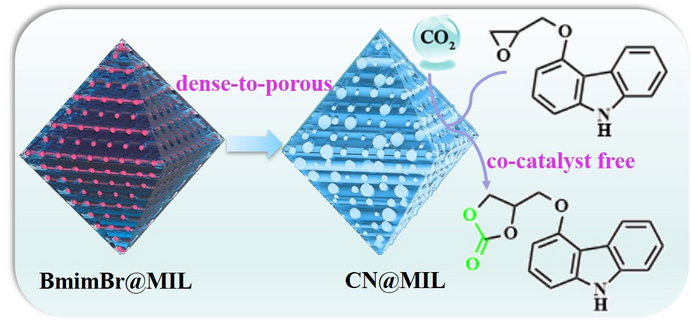Reviewed by Alex SmithJul 7 2022
Professors Yingwei Li and Kui Shen of the School of Chemistry and Chemical Engineering at the South China University of Technology are the study’s principal authors.
 The CN@MIL can efficiently facilitate the mass transfer of substrates, exhibiting excellent catalytic performance for the cycloaddition of 4-(2,3-epoxypropoxy) carbazole (4-EPC) to 4-(((9H-carbazol-4-yl) oxy) methyl)-1,3-dioxolan-2-one (4-CDO) under mild and co-catalyst-free condition. Image Credits: Science China Press
The CN@MIL can efficiently facilitate the mass transfer of substrates, exhibiting excellent catalytic performance for the cycloaddition of 4-(2,3-epoxypropoxy) carbazole (4-EPC) to 4-(((9H-carbazol-4-yl) oxy) methyl)-1,3-dioxolan-2-one (4-CDO) under mild and co-catalyst-free condition. Image Credits: Science China Press
In this study, they describe how N-doped carbon was enclosed in metal-organic frameworks (MOFs) with controlled nanoarchitectures and porosities as multifunctional catalysts for extremely effective CO2 fixation.
They created BmimBr@MIL, or MIL-101 embedded ionic liquids, which are then employed as a precursor to create composite materials with mesopore holes that range in size from 3.5 to 20 nm.
The crystallinity of MIL-101 can be kept intact during pyrolysis, and the N-doped nanocarbon (CN) that was generated in the framework of MIL-101 allowed for a dense-to-porous transition of the material’s structure.
With high catalytic performance in the synthesis of cyclic carbonates from epoxides and CO2 under moderate and co-catalyst-free conditions (90 °C and ambient pressure of CO2), the resulting CN@MIL can effectively promote the mass diffusion of substrates.
The study authors persisted in creating effective heterogeneous catalysts without co-catalysts for CO2 cycloaddition under benign circumstances. For in-situ encapsulation of N-doped nanocarbons into the pores of MOFs and the creation of multi-functional catalytic sites in the resulting MOF-based composites, their team presented a simple one-step pyrolysis technique.
They have discovered that the key to keeping MIL-101’s porous structure from collapsing is its improved thermal stability, which is caused by the space-occupying action of BmimBr.
Therefore, during pyrolysis, MIL-101’s crystallinity can be substantially maintained while also undergoing a dense-to-porous structural change with the creation of N-doped nanocarbon (CN) in the framework.
The mechanism of dense-to-porous transition by TG-MS was also studied by the researchers. The data obtained clearly shows that the ligands of BmimBr@MIL(0.67) can be broken down through a different method than those of its parent MIL-101, which further supports the idea that BmimBr@MIL(0.67improved)’s stability can effectively stop the porous structure of MIL-101 from collapsing.
They assessed the catalytic performances of the as-synthesized materials for the CO2 cycloaddition with large-size epoxides to concurrently study the benefits of hierarchical pores and multi-active sites of CN@MIL (400, 0.67, 30).
In the absence of co-catalysts, they discovered that the optimized CN@MIL (400, 0.67, 30) has good catalytic activity and can reach 96% yield in the cycloaddition of 4-(2,3-epoxypropoxy) carbazole (4-EPC) to 4-(((9H-carbazol-4-yl) oxy) methyl)-1,3-dioxolan-2-one (4-CDO).
This method of controlled pyrolysis offers a different and effective technique to combine MOFs with a variety of other functional big molecules for cutting-edge applications, as well as fresh insight into the pyrolysis of ILs contained inside MOF frameworks.
Journal Reference:
Chen, F., et al. (2022) N-doped nanocarbon embedded in hierarchically porous metal-organic frameworks for highly efficient CO2 fixation. Science China Chemistry. doi:10.1007/s11426-022-1298-9.